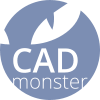Building 3D-models from the drawings, sketches, photos or cloud of points (3D-scan)
Modeling from designer's 2D sketches
We work with all type of sources: from the scans of ("on-the-napkin") sketches to the 2D-projections in CorelDraw etc.
Modeling from photos or screenshots.
We'll reconstruct the 3D model from the one or several photos or from the screenshots/videos. Generally the quality of your model depends from the quantity of original images, which let us to imagine its shape
Creating the solid or NURBS-model from the polygonal mesh or cloud of point
As a rule, it is required the accurate mathematical models (solids or NURBS-surfaces) for the production, but the original model there is only in a polygon form (for example it was created by designer in 3D Max or downloaded from one of the stores of models). We can convert such model into a NURBS or solid-state and store it in a right format, which the customer needs.
Another problem is a reverse engineering, the creation of a mathematical surface with the cloud of points (three-dimensional scanning). Also we can resolve another problem - processing of the huge files, which contains information about billions of points.
We can help you when the original model is lost and there is only a simplified polygonal model, for example, 3DXML or CGR.
The geometry of the final models: NURBS, solids or polygon mesh
When the model is done, we can send it to the customer in desired (one or several) formats, both universal or proprietary
Adjusting models for the prototyping (3D-printing) in STL format
Despite its apparent simplicity, many often make mistakes when preparing this model: polygons can be too much or too little, tessellation (splitting the surface into triangles) may be incorrect and the model will manifest angularity, even at high detail.
Designing of the products from sheet materials (metals, acrylic, plywood, etc.)
We'll construct a model in view of features of the material, optimizing the layout of parts on sheets, as well as taking into consideration the technology of cutting (laser and plasma cutting, milling, etc.) And further processing - welding, riveting, etc.
Building a 3D-model from MRI data (magnetic resonance imaging).
Such models can be used in teaching purposes, prosthetic creation, 3D-printing in real size


